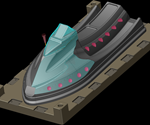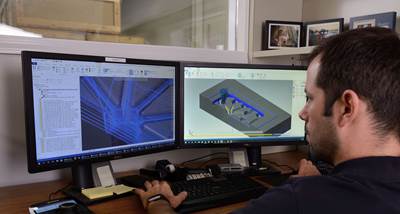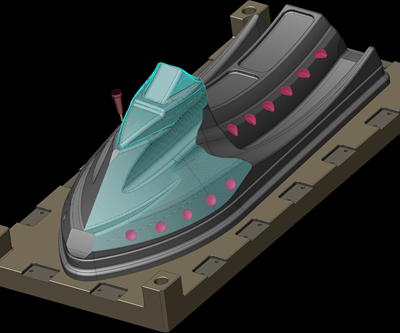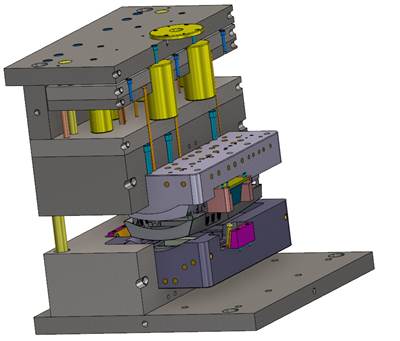
Newfound confidence in Mastercam CAD/CAM pushed Corey Robinson of Venom Outdoors to explore functions like Dynamic Motion technology, which allows operators to push their feed times past what was previously possible. Photo Credit: Mastercam, CNC Software Inc.
Cory Robinson has always seen the outdoors as his therapy. He grew up in Prescott, Wisconsin, on the Mississippi and St. Croix Rivers, practically living on his family’s fishing boat. So, it is no surprise that he started Venom Outdoors (New Richmond, Wisconsin), a fishing tackle company, in 2009. Venom started with the Venom Adjustable Fishing Floats, then expanded the ice fishing line with jigs and spoons, and has now branched into open water fishing products as well.
Local Wisconsin anglers might know Robinson as the mastermind behind his famous adjustable buoyancy bobber, allowing users to achieve neutral buoyancy with a large range of different jig sizes. This innovation is the cornerstone of Venom Outdoors.
“We try to develop cutting-edge products and go outside the box,” Robinson says. “Nothing is ever perfect; we can always expand on our enhancements.” Part of that dedication means not trusting other shops to uphold Venom’s expectations for quality. As Venom expanded, Robinson contracted products out to overseas manufacturers. That didn’t last long.
“We ran into some major obstacles with regards to the quality. By the second year, the wheels fell right off the entire operation, and we knew we could do better for our customers,” Robinson says. He bought a Haas vertical milling center and some other production equipment. He has had full control over the creation process ever since. Robinson and his partner, Rebecca, take a design from conception to the store wall and control everything in between.

Venom customers trust the company will provide high-quality lures that can land them trophy fish, like this perch. Photo Credit: Venom Outdoors
Most of the products are injection molded, and each product comes with its unique challenges. Some of the lures are small (as light as 0.025 ounces), and the tooling may have cavities of different sizes. On top of that, each design must move a specific way underwater.
For example, the team repeatedly tweaked the 221 Flutter Spoon to achieve the consistent fluttering action underwater that drives fish crazy and incites a bite. They designed the 221 with two line attachments to give the spoon two distinct actions when pulled up through the water.
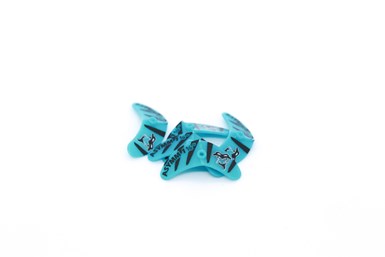
Venom Outdoors products are intricate. For example, lures can be as light as 0.025 ounces. Generally, the company requires molds with cavities of varying sizes and designs that allow the product to move a specific way underwater. Photo Credit: Venom Outdoors
Then, they strategically placed the center of mass to get a slow lifelike fall on the way down. The goal was to produce an action that mimicked an injured prey fish dropping to the bottom of a body of water.
Robinson says that he was adjusting these designs by 0.010 inch during this process until he got what he needed. With so much trial and error, he had to program fast and make changes even faster.
Consistency Is Key
“I need to get sound toolpaths consistently so that when I see it on the screen, I can say, ‘Yes, I trust that path’ and go with it,” Robinson says. To accomplish this, he uses Mastercam CAD/CAM software from CNC Software Inc. (Tolland, Connecticut).
The software Robinson used before Mastercam had an outdated interface that was unintuitive and difficult to maneuver. Robinson may have been able to power through if not for the fact that he was burning through high-performance cutters with expensive coatings because the system was changing parameters on its own.
“Feeds and speeds were randomly changing, it was finding random Z depths to cut to and wear comp was being turned on and off in the wrong places in the code. It would shut off while the cutter was engaged and gouge the part. We were struggling like mad to get solid toolpaths laid out,” Robinson says. Robinson taught himself multiple CAD/CAM systems, earned multiple patents and started his own business, so settling for the reseller saying “that’s impossible” was not an option.

Robinson purchased a Haas VMC and with his partner took on control of design all the way through to the store shelves. Photo Credit: Venom Outdoors
He decided that he couldn’t afford to be nervous about hitting the Cycle Start button on his machine and went with what he knew would work. “I’m not making this up when I say that we got more done with Mastercam in the first three weeks than we did with that other software in nine months,” Robinson says.
Innovation Is Necessary
Robinson says he can get the Mastercam software to do “some pretty wild and powerful things without any extensive formal training.” The intuitiveness of the interface makes learning easy while still allowing advanced programming, and it pairs seamlessly with SolidWorks. Instead of spending his time worrying about potential crashes or tool breakage, Robinson says he can now focus on innovating.
Robinson can also quickly and easily add operations to modify a part, copy existing toolpaths to other features without reprogramming and use the power of the CAD program to make Mastercam even more effective. With Mastercam running inside SolidWorks, he is able to insert an external part into an already programmed part and use the same toolpaths to machine different-sized cavities and features.
Robinson’s newfound confidence pushed him to explore functions like Dynamic Motion technology, allowing operators to push their feed times past what was possible before. Dynamic toolpaths like OptiRough reduce cycle times by up to 75% by adjusting tool motion in real time to maintain consistent chip load. This optimizes energy dispersal so that the chips carry almost all of the heat from machining, leaving the tool and part cool and increasing safety.
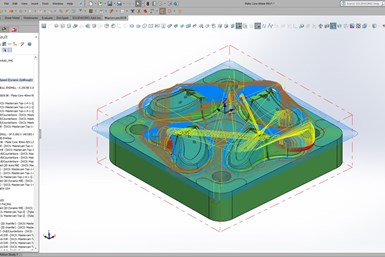
With Mastercam running with SolidWorks, Venom Outdoors can insert an external part into an already programmed part and use the same toolpaths to machine different-sized cavities and features. Photo Credit: Mastercam, CNC Software Inc.
“I had some hesitation with using it alongside my smaller end mills, the 0.020-0.015-inch sizes. It bumped that feed up an awful lot, but that radial chip feature gave me that trust I needed when running my machine. I’ve never broken a small cutter with OptiRough,” Robinson says. Further, he can run his machines faster than ever without fear of breaking his expensive cutters or gouging his molds.
Now, Robinson buys one piece of tool steel for each part with the expectation of success. It gives him the freedom to focus on creativity. He points to glow-in-the-dark lures as examples. Some ice fishing lures have slots where miniature glow sticks can be placed. However, these glow sticks are a one-time-use product and need to be thrown away and replaced. Robinson feels that consumable parts are not cost effective for the customer, and replacing the small parts in a cold environment can be cumbersome and frustrating.
Also, the light created by the chemical reaction is slowed or stops in a cold environment and therefore is not reliable in this type of application. Robinson has found a way to maximize the “fuel tank” for the glow so that one glow-in-the-dark jig will glow underwater for much longer than the usual five minutes.
“I’m not making this up when I say that we got more done with Mastercam in the first three weeks than we did with that other software in nine months.”
“The accuracy of today’s machinery and CAM code allows us to machine with absolute precision for these very intricate products. It is always our goal to be ahead of the competition, and having these tools in place allows us to forge new paths in our industry,” he says.
Venom currently relies on about a dozen people for assembly and packaging, but Robinson thinks that soon he will need to bring on more specialized employees to help with the technical aspects of the design and manufacturing process. He plans to buy a wire EDM, sinker EDM and a CNC lathe to expand their capabilities even further.
Related Content
Tolerancing in Mold Design, Part 1: Understanding the Issues of Conventional Bilateral Tolerancing
Mold designers must understand the location, orientation and form limitations of conventional tolerancing before changing to another dimensioning system.
Read MoreHow to Improve Your Current Efficiency Rate
An alternative approach to taking on more EDM-intensive work when technology and personnel investment is not an option.
Read MoreIt Starts With the Part: A Plastic Part Checklist Ensures Good Mold Design
All successful mold build projects start with examining the part to be molded to ensure it is moldable and will meet the customers' production objectives.
Read MoreHow a Small Programming Change Cuts Cycle Time in Half
Overriding the CAM system when milling a series of lifter pockets helps to improve metal removal rate and increase feed rates.
Read MoreRead Next
CAM/Cutting Tool Combo Improves Mold Finishes
Combining CAM software, specialty carbide end mills, and reseller support optimizes existing mills for machining molds at an electrical components manufacturer.
Read MoreA CAD-for-CAM Toolbox Helps Moldmakers Design Better Molds
An important CAD function that a CAM package should offer moldmakers is a set of specialized CAD-for-CAM tools that focus on the machinist’s needs after the machinist opens the part file.
Read MoreAdvanced CAM Software Streamlines Solid Modeling, Toolpath Creation, Verification and Connectivity
Advanced CAD/CAM improves performance of cutting tool designs, probing, process simulation and verification and data gathering and monitoring.
Read More



